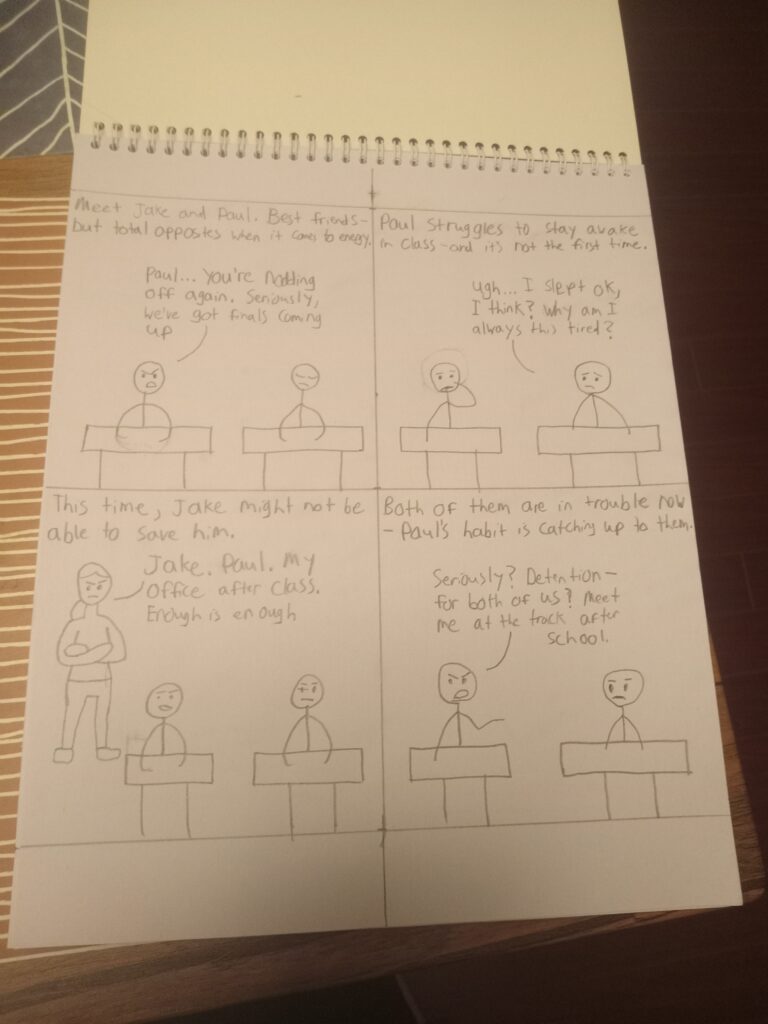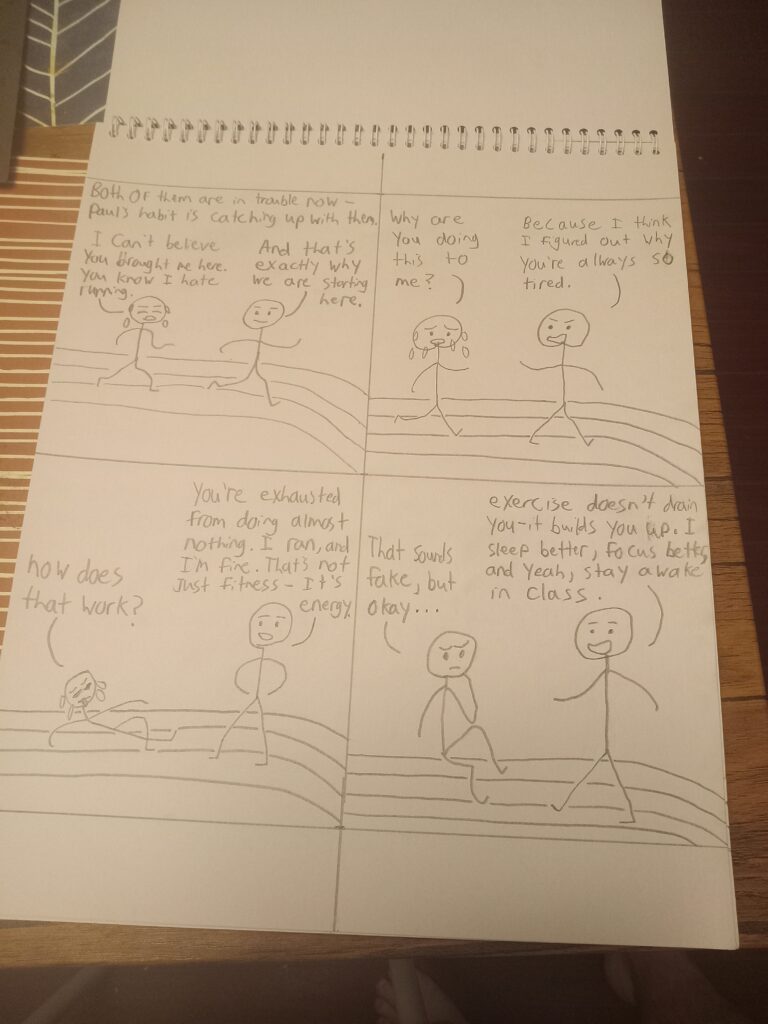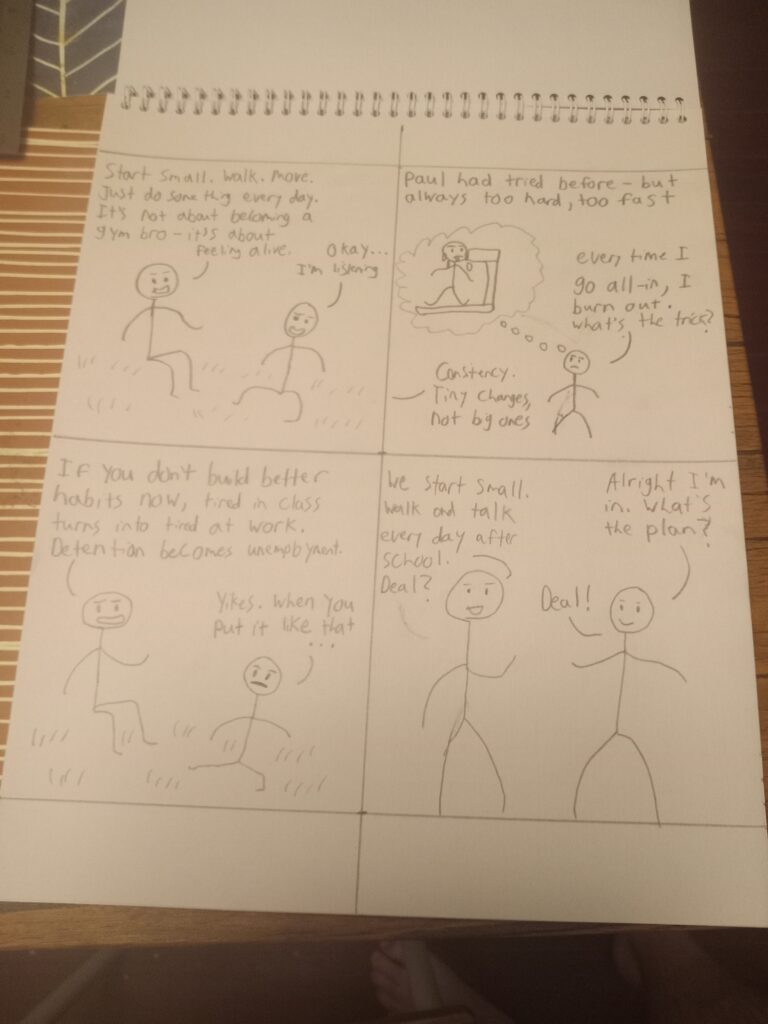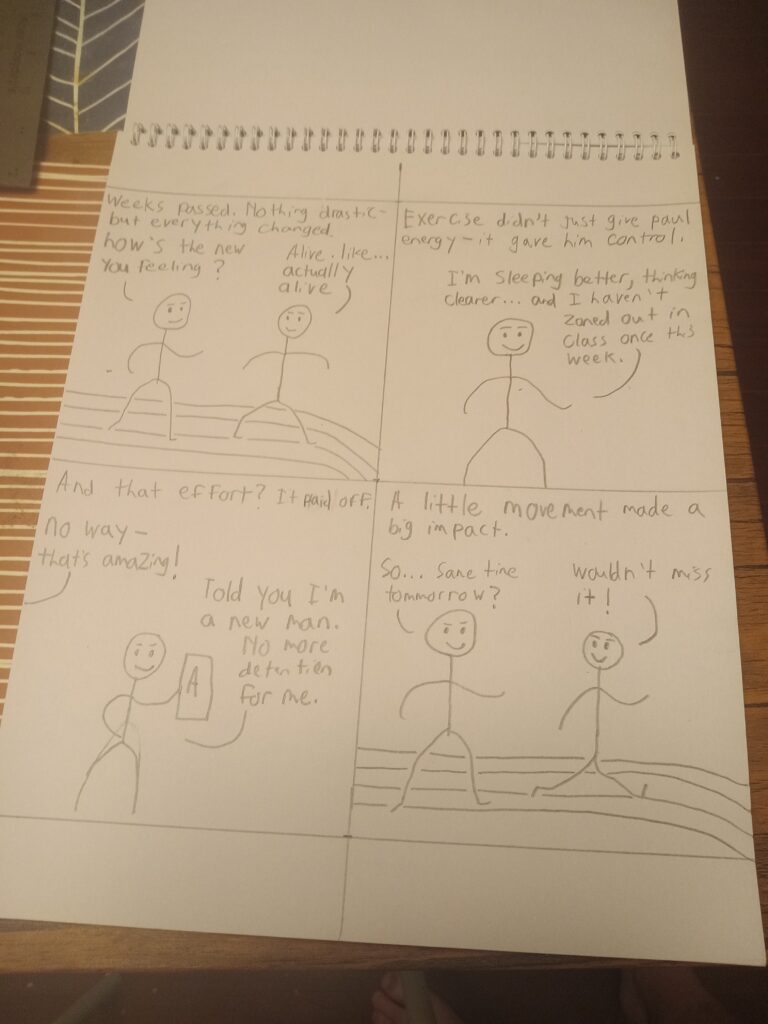Challenge A – The importance of exercise
Learning Challenge
So many youth today are simply just not getting enough exercise, and it shows. They simply don’t see the value in it and in this comic I aim to demonstrate its importance.
Context and Audience
This comic is meant to be a guide for students of all ages but particularly targets those in high school, as they are the ones getting the least amount of exercise. Students in high school are spending more and more time on technology, while spending less time getting exercise. It is affecting their overall health in a negative way, which is why I aim to show how by making adjustments to how much exercise they are getting they will see improvements in other areas such as sleep quality, school performance and their overall energy levels.
Point of View Statement
Students need to understand how increasing their amount of exercise will lead to improvements in their overall sleep quality, their performance in school and their overall energy levels.
Learning Objectives
The primary learning objectives of this project are that students will be able to recognize the changes needed to be made in their lives to get more exercise and why that is important. They will also recognize how not only are they healthier and getting more exercise, but they’ll find themselves feeling mentally sharper as well as getting better quality sleep. They will become much better at seeing how their decisions around getting adequate exercise are impacting them in other areas and begin to see the value in that. The goal is that students will be able to begin applying some of what they have learned to their own routines.
Ideation Process
I first started by trying to put myself in the shoes of the learner, by thinking of the patterns I’ve seen in teenagers I’ve worked with as an EA at high schools. One thing that really stood out to me in this process is that at that particular age group, they are very social and care a lot about their friends. They want to fit in and because most teenagers engage in social media, videogames and lots of screen time, that is what most kids choose to do. So I thought, what if I could demonstrate a kid that fits this status quo and is struggling. They aren’t exercising, they’re tired, they have no energy and school just isn’t going their way. But they got this really cool friend that is the total opposite and exercises a lot while still fitting in. This would demonstrate how kids can exercise while still being able to fit in with their friends because that is important to them.
Final Script
Panel 1
Image: Jake is focused in class; Paul is next to him, nodding off mid-lesson.
Narration: Meet Jake and Paul. Best friends—but total opposites when it comes to energy.
Jake (whispering): “Paul… you’re nodding off again. Seriously, we’ve got finals coming up.”
Panel 2
Image: Paul jolts awake, rubbing his eyes.
Narration: Paul struggles to stay awake in class—and it’s not the first time.
Paul: “Ugh… I slept okay, I think? Why am I always this tired?”
Panel 3
Image: The teacher glares from the front of the room after hearing whispers.
Narration: This time, Jake might not be able to save him.
Teacher: “Jake. Paul. My office after class. Enough is enough.”
Panel 4
Image: Paul looks guilty. Jake looks frustrated.
Narration: Both of them are in trouble now—Paul’s habit is catching up with them.
Jake: “Seriously? Detention—for both of us? Meet me at the track after school.”
Panel 5
Image: Paul drags himself toward the track. Jake waits, stretching.
Paul: “I can’t believe you brought me here. You know I hate running.”
Jake: “And that’s exactly why we’re starting here.”
Panel 6
Image: Jake jogs easily; Paul struggles, out of breath, after a short distance.
Paul (panting): “Why are you doing this to me?”
Jake: “Because I think I figured out why you’re always so tired.”
Panel 7
Image: Paul collapsed on the ground. Jake stands nearby, barely winded.
Jake: “You’re exhausted from doing almost nothing. I just ran, and I’m fine. That’s not just fitness—it’s energy.”
Paul: “How does that work?”
Panel 8
Image: Paul sits up, thinking.
Jake: “Exercise doesn’t drain you—it builds you up. I sleep better, focus better, and yeah, stay awake in class.”
Paul: “That sounds fake, but okay…”
Panel 9
Image: Jake sits next to Paul on the grass.
Jake: “Start small. Walk. Move. Just do something every day. It’s not about becoming a gym bro—it’s about feeling alive.”
Paul: “Okay… I’m listening.”
Panel 10
Image: Flashback style—Paul trying intense workouts in the past and quitting quickly.
Narration: Paul had tried before—but always too hard, too fast.
Paul: “Every time I go all-in, I burn out. What’s the trick?”
Jake: “Consistency. Tiny changes, not big ones.”
Panel 11
Image: Paul looking reflective.
Jake: “If you don’t build better habits now, tired in class turns into tired at work. Detention becomes unemployment.”
Paul: “Yikes. When you put it like that…”
Panel 12
Image: Paul stands up, dusting himself off.
Paul: “Alright. I’m in. What’s the plan?”
Jake: “We start small. Walk and talk, every day after school. Deal?”
Paul: “Deal.”
Panel 13
Image: A few weeks later. Paul and Jake walk the track, relaxed and laughing.
Narration: Weeks passed. Nothing drastic—but everything changed.
Jake: “How’s the new you feeling?”
Paul: “Alive. Like… actually alive.”
Panel 14
Image: Paul looks healthy, focused, and confident.
Narration: Exercise didn’t just give Paul energy—it gave him control.
Paul: “I’m sleeping better, thinking clearer… and I haven’t zoned out in class once this week.”
Panel 15
Image: Paul proudly holds up a paper marked with an “A.”
Narration: And that effort? It paid off.
Jake: “No way—that’s amazing!”
Paul: “Told you I’m a new man. No more detention for me.”
Panel 16
Image: The two walk off the track, still chatting.
Narration: A little movement made a big impact.
Jake: “So… same time tomorrow?”
Paul: “Wouldn’t miss it.”
Peer feedback:
After receiving peer feedback on my original comic script, I revised the story to improve clarity, tone, and focus. One suggestion was to make Jake feel more like a peer than a teacher, as he originally came off as overly instructional. In the revised version, I adjusted Jake’s dialogue to be more conversational and supportive, emphasizing a shared journey rather than giving lectures. Another point of feedback asked whether the focus was on exercise or healthy habits in general. I clarified this by centering the story around exercise as the key habit that leads to better energy, sleep, and academic performance. I also responded to a suggestion to show Paul’s success more clearly by adding a panel where he proudly receives an A on a test, giving the audience a tangible outcome to his growth. To address comments about repetition in the beginning, I condensed the opening scenes where Paul is tired in class to keep the pacing tighter and more engaging. Finally, while the story is still aimed at a high school audience, I simplified some of the dialogue to make it more accessible and adaptable for younger students if needed. Overall, the feedback helped me strengthen the narrative, make the characters more relatable, and deliver a clearer, more impactful message.
Principle
The Coherence Principle is applied by using visuals that relate to the dialogue and keeping that dialogue relatively short as well as to the point so as to not take away from the main message. The Contiguity Principle is applied by having the text and images in each panel in a way that they are able to be processed together. The Segmenting Principle is applied by breaking this comic down into 16 panels that follow a progressive pattern that ensures ideas are processed one at a time so as to not make it overwhelming. The Modality Principle is used by combining the text, the narration and the images using multiple ways of processing which encourages a much deeper level of learning.
Final Comic



